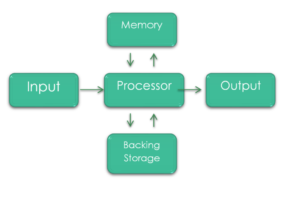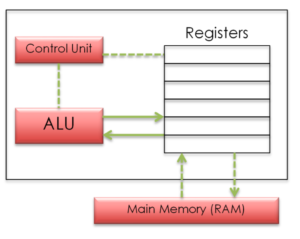
The Processor (CPU)
The processor is the brains of the computer and deals with all the movement of data and any calculations to be carried out. Computers can carry out instructions very quickly because the CPU can process billions of instructions every second although it only does one at a time.
The processor is made up from:
- The Control Unit (CU)
- The Arithmetic and Logic Unit (ALU)
- Registers

The Control Unit
The control unit is responsible for managing the clock, read, write, reset and interrupt lines.
The control unit has a clock line that sends out a signal to synchronise the fetch/execute cycle. Clock speed is measured in Hertz (Hz) and is a good indication of how quickly the processor can complete tasks. Modern processors for desktop PCs operate in GHz.
The Arithmetic and Logic Unit (ALU)
All calculations and logical decisions are handled by the ALU. Processing real numbers would be an example of an action performed by the ALU.
- performs all calculations
- performs comparisons on numeric values
- makes decisions based on logic (AND, OR, NOT)
The Registers
- Registers are small temporary memory locations located on the processor.
- They are used to store the data for the current instruction being processed
For example
The accumulator is a register that stores the results of calculations preformed buy the ALU. The Instructions register holds the program instruction that is currently being decoded and executed.
